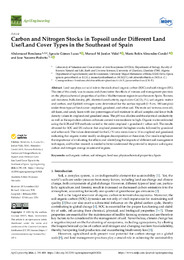Por favor, use este identificador para citar o enlazar este ítem:
https://hdl.handle.net/11000/34704Registro completo de metadatos
| Campo DC | Valor | Lengua/Idioma |
|---|---|---|
| dc.contributor.author | Benslama, Abderraouf | - |
| dc.contributor.author | Gómez Lucas, Ignacio | - |
| dc.contributor.author | Jordan Vidal, Manuel M. | - |
| dc.contributor.author | Almendro-Candel, María Belén | - |
| dc.contributor.author | Navarro-Pedreño, Jose | - |
| dc.contributor.other | Departamentos de la UMH::Agroquímica y Medio Ambiente | es_ES |
| dc.date.accessioned | 2025-01-16T18:46:40Z | - |
| dc.date.available | 2025-01-16T18:46:40Z | - |
| dc.date.created | 2024-02 | - |
| dc.identifier.citation | AgriEngineering, 2024, 6, 396–408 | es_ES |
| dc.identifier.isbn | 2624-7402 | - |
| dc.identifier.uri | https://hdl.handle.net/11000/34704 | - |
| dc.description.abstract | Land use plays a crucial role in the stock of soil organic carbon (SOC) and soil nitrogen (SN). The aim of this study was to assess and characterize the effects of various soil management practices on the physicochemical properties of soil in a Mediterranean region in southeastern Spain. Texture, soil moisture, bulk density, pH, electrical conductivity, equivalent CaCO3 (%), soil organic matter and carbon, and Kjeldahl nitrogen were determined for the surface topsoil (0–5 cm, 180 samples) under three types of land cover: cropland, grassland, and urban soil. The main soil textures were silt, silt loam, and sandy loam with low percentages of soil moisture in all soil samples and lower bulk density values in cropland and grassland areas. The pH was alkaline and the electrical conductivity as well as the equivalent calcium carbonate content were moderate to high. Organic matter estimated using the LOI and WB methods varied in the order cropland > grassland > urban soil. The results obtained for SOC and SN indicate that cropland presented the highest stocks, followed by grassland and urban soil. The values determined for the C/N ratio were close to 10 in cropland and grassland, indicating that organic matter readily undergoes decomposition at these sites. Our results emphasize the importance of evaluating the effects and identifying the impacts of different soil management techniques, and further research is needed to better understand the potential to improve soil organic carbon and nitrogen storage in semiarid regions | es_ES |
| dc.format | application/pdf | es_ES |
| dc.format.extent | 13 | es_ES |
| dc.language.iso | eng | es_ES |
| dc.publisher | MDPI | es_ES |
| dc.rights | info:eu-repo/semantics/openAccess | es_ES |
| dc.rights | Attribution-NonCommercial-NoDerivatives 4.0 Internacional | * |
| dc.rights.uri | http://creativecommons.org/licenses/by-nc-nd/4.0/ | * |
| dc.subject | soil organic carbon | es_ES |
| dc.subject | soil nitrogen | es_ES |
| dc.subject | land use | es_ES |
| dc.subject | physicochemical properties | es_ES |
| dc.subject | Spain | es_ES |
| dc.subject.other | CDU::6 - Ciencias aplicadas::62 - Ingeniería. Tecnología | es_ES |
| dc.title | Carbon and Nitrogen Stocks in Topsoil under Different Land Use/Land Cover Types in the Southeast of Spain | es_ES |
| dc.type | info:eu-repo/semantics/article | es_ES |
| dc.relation.publisherversion | https://doi.org/ 10.3390/agriengineering6010024 | es_ES |

Ver/Abrir:
10.3390agriengineering6010024.pdf
1,05 MB
Adobe PDF
Compartir:
 La licencia se describe como: Atribución-NonComercial-NoDerivada 4.0 Internacional.
La licencia se describe como: Atribución-NonComercial-NoDerivada 4.0 Internacional.
.png)